NASA wants to revive its storied "X-plane" division, one of the coolest aviation programs ever, with an eye toward making the future of commercial flight quieter, more efficient, and much, much faster.
In a budget request published this month, NASA---which, remember, has "aeronautics" in its name as well as "space"---announced plans to revive the experimental program that started after World War II and created some of history's most remarkable aircraft. Its milestones include the X-1 (first aircraft to break the sound barrier), the X-5 (first plane with variable sweep wings), the X-13 (first use of jet power for vertical takeoffs and landings), the X-31A (could turn 180 degrees in the air), and many more. The program was synonymous with the dawn of the jet age and continued building airplanes into the last decade. Its last plane was the unmanned X-51A "Waverider," designed to fly at six times the speed of sound (roughly 4,000 mph) by riding its own shockwave. Like many x-planes, the Waverider was developed with military applications in mind.
Now NASA is interested in making flying a better experience for the rest of us. The agency plans a "bold series of new experimental aircraft" to develop the technologies needed to cut the fuel consumption of commercial airplanes in half, reduce emissions by 75 percent, promote the use of renewable energy, and reduce noise levels around airports.
Those are ambitious, noble goals: Aviation's responsible for 1.5 percent of the planet's anthropogenic greenhouse gas emissions, and demand for air travel is booming in the developing world. Planes have to get more efficient---the global aviation industry just last week agreed to a four percent reduction in fuel consumption by 2028---and NASA should be helping that effort.
Still, it's exciting to see that the aeronautics agency isn't all about cutting carbon. It's already got its next x-plane in mind, and this one, like so many of its predecessors, is all about going fast.
We've been flying at subsonic speeds like total lame-o's since the Concorde left service in 2003. Today's airliners typically fly around Mach .8 (~600 mph), leaving you stuck in that middle seat way longer than you'd like to be there. NASA thinks it's time to remedy that. The agency plans "to initiate the detailed design and build of the world’s first low-boom flight demonstrator."
The problem with flying faster than the speed of sound is just how terrible it is for everyone on the ground. The sonic boom that results from an aircraft breaking the sound barrier is unpleasant and occasionally damaging. In the 1950s and 60s, when the military's supersonic jets were shooting all over the place, Americans filed nearly 40,000 claims against the Air Force, according to Lawrence R. Benson's book Quieting the Boom: The Shaped Sonic Boom Demonstrator and the Quest for Quiet Supersonic Flight. Complaints ranged from broken glass to dead pets and livestock driven insane.
That led the FAA in 1973 to ban supersonic commercial flights over the United States, saying "present technology cannot deal in a practical way with the sonic boom problem." That's why the Concorde stuck to routes between the East Coast and Europe, only firing up to full speed over the Atlantic and limiting its earning potential.
But if you can get rid of the sonic boom, or at least drastically reduce its negative effects, the US and other countries that imitated its ban might be persuaded to allow the revival of supersonic flight. That's the goal of the "low boom" aircraft, NASA says: "to overcome the sonic boom barrier and open the door for development of a new generation of supersonic civil transport aircraft."
NASA hasn't said much about how that plane will reduce the boom, except that it will try to validate work it's done in the wind tunnel. The general idea is to shape the plane so the shockwave it produces isn't quite so rough for those on the ground. The plan right now is to produce a preliminary design review in FY 2016, with a detailed design in FY 2017. The agency's not the only one working on this problem: Boeing, Airbus, Lockheed Martin, have shown concepts for supersonic aircraft in the past few years, and billionaire-backed Aerion Corp. plans to deliver a supersonic business jet around 2023.
If all goes according to plan, there will be a nice circularity to NASA's revived program: The first x-plane sent Chuck Yeager past Mach 1. The next one could let everyone else follow him there.



